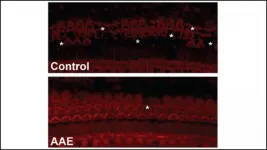(Press-News.org) HOUSTON - (June 21, 2021) - Diamond may be just a phase carbon goes through when exposed to a flash of heat, but that makes it far easier to obtain.
The Rice University lab of chemist James Tour is now able to "evolve" carbon through phases that include valuable nanodiamond by tightly controlling the flash Joule heating process they developed 18 months ago.
Best of all, they can stop the process at will to get product they want.
In the American Chemical Society journal ACS Nano, the researchers led by Tour and graduate student and lead author Weiyin Chen show that adding organic fluorine compounds and fluoride precursors to elemental carbon black turns it into several hard-to-get allotropes when flashed, including fluorinated nanodiamonds, fluorinated turbostratic graphene and fluorinated concentric carbon.
With the flash process introduced in 2020, a strong jolt of electricity can turn carbon from just about any source into layers of pristine turbostratic graphene in less than a second. ("Turbostratic" means the layers are not strongly bound to each other, making them easier to separate in a solution.)
The new work shows it's possible to modify, or functionalize, the products at the same time. The duration of the flash, between 10 and 500 milliseconds, determines the final carbon allotrope.
The difficulty lies in how to preserve the fluorine atoms, since the ultrahigh temperature causes the volatilization of all atoms other than carbon. To overcome the problem, the team used a Teflon tube sealed with graphite spacers and high-melting-point tungsten rods, which can hold the reactant inside and avoid the loss of fluorine atoms under the ultrahigh temperature. The improved sealed tube is important, Tour said.
"In industry, there has been a long-standing use for small diamonds in cutting tools and as electrical insulators," he said. "The fluorinated version here provides a route to modifications of these structures. And there is a large demand for graphene, while the fluorinated family is newly produced here in bulk form."
Nanodiamonds are microscopic crystals -- or regions of crystals -- that display the same carbon-atom lattice that macro-scale diamonds do. When first discovered in the 1960s, they were made under heat and high pressure from detonations.
In recent years, researchers have found chemical processes to create the same lattices. A report from Rice theorist Boris Yakobson last year showed how fluorine can help make nanodiamond without high pressure, and Tour's own lab demonstrated using pulsed lasers to turn Teflon into fluorinated nanodiamond.
Nanodiamonds are highly desirable for electronics applications, as they can be doped to serve as wide-bandgap semiconductors, important components in current research by Rice and the Army Research Laboratory.
The new process simplifies the doping part, not only for nanodiamonds but also for the other allotropes. Tour said the Rice lab is exploring the use of boron, phosphorous and nitrogen as additives as well.
At longer flash times, the researchers got nanodiamonds embedded in concentric shells of fluorinated carbon. Even longer exposure converted the diamond entirely into shells, from the outside in.
"The concentric-shelled structures have been used as lubricant additives, and this flash method might provide an inexpensive and fast route to these formations," Tour said.
Co-authors of the paper are Rice graduate students John Tianci Li, Zhe Wang, Wala Algozeeb, Emily McHugh, Kevin Wyss, Paul Advincula, Jacob Beckham and Bo Jiang, research scientist Carter Kittrell and alumni Duy Xuan Luong and Michael Stanford. Tour is the T.T. and W.F. Chao Chair in Chemistry as well as a professor of computer science and of materials science and nanoengineering at Rice.
The Air Force Office of Scientific Research and the Department of Energy supported the research.
INFORMATION:
Read the abstract at https://pubs.acs.org/doi/10.1021/acsnano.1c03536.
This news release can be found online at https://news.rice.edu/2021/06/21/flashed-nanodiamonds-are-just-a-phase/
Follow Rice News and Media Relations via Twitter @RiceUNews.
Related materials:
Rice lab turns trash into valuable graphene in a flash: http://news.rice.edu/2020/01/27/rice-lab-turns-trash-into-valuable-graphene-in-a-flash-2/
Tour Group: https://www.jmtour.com
Department of Chemistry: https://chemistry.rice.edu
Wiess School of Natural Sciences: https://naturalsciences.rice.edu
Images for download:
https://news-network.rice.edu/news/files/2021/06/0621_DIAMOND-1-WEB.jpg
The mechanism by Rice University chemists for the phase evolution of fluorinated flash nanocarbons shows stages with longer and larger energy input. Carbon and fluorine atoms first form a diamond lattice, then graphene and finally polyhedral concentric carbon. (Credit: Illustration by Weiyin Chen/Rice University)
https://news-network.rice.edu/news/files/2021/06/0621_DIAMOND-2-WEB.jpg
A transmission electron microscope image shows a nanodiamond lattice. Rice University chemists used their flash Joule heating technique to control the phase evolution and doping of carbon. (Credit: Tour Group/Rice University)
https://news-network.rice.edu/news/files/2021/06/0621_DIAMOND-3-WEB.jpg
An electron microscope image shows a late stage in the evolution of carbon and fluorine atoms under flash Joule heating. The carbon atoms form concentric shells around a nanodiamond core. As heating proceeds, the diamond phase is replaced by the shell. (Credit: Tour Group/Rice University)
Located on a 300-acre forested campus in Houston, Rice University is consistently ranked among the nation's top 20 universities by U.S. News & World Report. Rice has highly respected schools of Architecture, Business, Continuing Studies, Engineering, Humanities, Music, Natural Sciences and Social Sciences and is home to the Baker Institute for Public Policy. With 3,978 undergraduates and 3,192 graduate students, Rice's undergraduate student-to-faculty ratio is just under 6-to-1. Its residential college system builds close-knit communities and lifelong friendships, just one reason why Rice is ranked No. 1 for lots of race/class interaction and No. 1 for quality of life by the Princeton Review. Rice is also rated as a best value among private universities by Kiplinger's Personal Finance.
Jeff Falk
713-348-6775
jfalk@rice.edu
Mike Williams
713-348-6728
mikewilliams@rice.edu
LAWRENCE -- Tulsa may not be the first town one thinks of when talking about jazz, and flood management may not be the first vocation one compares to the musical genre. But the success Tulsa displayed in going from one of the nation's most flood-prone cities to a nationally recognized model of long-term risk reduction in just two decades is analogous to the evolution of one of the most American styles of music, a University of Kansas professor points out in a new study.
Tulsa, the second-largest city in Oklahoma, suffered several devastating floods in the 1970s and 1980s, then became a national model for flood mitigation by the 1990s. What hasn't been studied closely is how a group of engineers, planners, government officials, journalists, attorneys and citizens came together ...
The word "tsunami" brings immediately to mind the havoc that can be wrought by these uniquely powerful waves. The tsunamis we hear about most often are caused by undersea earthquakes, and the waves they generate can travel at speeds of up to 250 miles per hour and reach tens of meters high when they make landfall and break. They can cause massive flooding and rapid widespread devastation in coastal areas, as happened in Southeast Asia in 2004 and in Japan in 2011.
But significant tsunamis can be caused by other events as well. The partial collapse of the volcano Anak Krakatau in Indonesia in 2018 caused a tsunami that killed more than 400 people. Large landslides, which send immense amounts of debris into the sea, also ...
Following fertilization, early plant embryos arise through a rapid initial diversification of their component cell types. As a result, this series of coordinated cell divisions rapidly sculpts the embryo's body plan. The developmental phenomenon in question is orchestrated by a transcriptional activation of the plant genome. However, the underlying cellular differentiation programs have long remained obscured as the plant embryos were hard to isolate. In fact, previous attempts at creating datasets of the plant embryonic differentiation programs were incapable ...
A commonly studied perovskite can superfluoresce at temperatures that are practical to achieve and at timescales long enough to make it potentially useful in quantum computing applications. The finding from North Carolina State University researchers also indicates that superfluorescence may be a common characteristic for this entire class of materials.
Superfluorescence is an example of quantum phase transition - when individual atoms within a material all move through the same phases in tandem, becoming a synchronized unit.
For example, when atoms in an optical material such as a perovskite are excited they can individually radiate light, create energy, and fluoresce. Each atom will start moving through these phases randomly, but given the right conditions, they can synchronize in ...
All plant cells obtain their energy mainly from two organelles they contain - chloroplasts (responsible for photosynthesis) and mitochondria (responsible for the biochemical cycle of respiration that converts sugars into energy). However, a large number of a plant cell's genes in its mitochondria and chloroplasts can develop defects, jeopardising their function. Nevertheless, plant cells evolved an amazing tool called the RNA editosome (a large protein complex) to repair these kinds of errors. It can modify defective messenger RNA that result from defective DNA by transforming (deamination) of certain mRNA nucleotides.
Automatic error correction in plant cells
Automatic error correction in plants was discovered about 30 years ago by a team headed by plant physiologist Axel Brennicke ...
While the LGBTQ+ community has seen significant advancements in legal rights, political representation and social acceptance over recent years, mental and physical health disparities still exist for queer Americans - and are even worse among younger generations, says a new study from Michigan State University.
In the first-ever population-based national study comparing mental and physical health of lesbian, gay and bisexual (LGB) Americans to their straight counterparts, MSU sociologist Hui Liu and research partner Rin Reczek, professor of sociology from Ohio State University, found that when compared to their straight counterparts, LGB Millennials have worse health disadvantages than their older peers, though disparities persist throughout older generations as ...
All coronaviruses produce four primary structural proteins and multiple nonstructural proteins. However, the majority of antibody-based SARS-CoV-2 research has focused on the spike and nucleocapsid proteins. A study published in PLOS Biology by Anna Heffron, Irene Ong and colleagues at the University of Wisconsin-Madison, USA, suggests that immune responses may develop against other proteins produced by the SARS-CoV-2 virus.
The efficacy of spike protein-based vaccines is variable and not everyone infected with SARS-CoV-2 produces detectable antibodies against the spike or ...
In a new study published today in the American Journal of Human Genetics, researchers announced the development of a new method to increase the utility and equity of large genetic databases. The research was conducted by Audrey Hendricks, an associate professor of statistics at the University of Colorado Denver (CU Denver).
Summix, the new method developed by Hendricks and her team of CU Denver undergraduate and graduate students, estimates the genetic ancestry in databases and adjusts the information to match the ancestry of a person or sample of people. This method leads large genetic databases to become more useful for people of various ancestries such as African American or Latinx, as they are underrepresented in genetic ...
Every day, our bodies face a bombardment of UV rays, ozone, cigarette smoke, industrial chemicals and other hazards.
This exposure can lead to free-radical production in our bodies, which damages our DNA and tissues. A new study from West Virginia University researcher Eric E. Kelley--in collaboration with the University of Minnesota--suggests that unrepaired DNA damage can increase the speed of aging.
The study appears in the journal Nature.
Kelley and his team created genetically-modified mice with a crucial DNA-repair protein missing from their hematopoietic stem cells, immature immune cells that develop into white blood cells. Without this ...
Broadband sounds embedded with short pauses can maintain temporal sound processing in a mouse model of hearing loss, according to new research published in eNeuro.
Hearing loss treatments supplement auditory system function but don't repair it. However a new intervention -- playing broadband sounds during the onset of hearing loss -- may be able to prevent the damage from ever occurring. Augmented auditory environments have been able to preserve auditory processing of a wide range of sound frequencies in mice models. In a new study, Dziorny et al. modified the traditional paradigm and preserved the processing of time-related, or temporal, sound features which are vital for understanding speech.
The research team exposed mice with congenital hearing loss to ...



